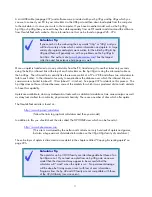
Some typical aplet views
The Sequence aplet (see page 99)
Handles sequences such as
T
n
=
2
T
n
−
1
+
3;
T
1
=
2
or
T
=
2
n
−
1
. Allows you to explore
n
recursive and non-recursive sequences.
The Solve aplet (see page 105)
Solves equations for you. Given an equation such as
A
=
2
π
r
r
+
h
)
it will solve for any
variable if you tell it the values of the others.
(
The Statistics aplet (see page 114 & 123)
Handles descriptive statistics. Data entry is easy, as is editing. It analyzes univariate and
bivariate data, drawing scatter graphs, histograms and box & whisker graphs and finding
lines of best fit, linear and non-linear.
The Triangle Solve aplet (see page 152 )
This aplet solves for sides and angles in triangles.
The Trig Explorer aplet (see page 162)
This is a teaching aplet, allowing the student to investigate the properties of sine and cosine
graphs in the same interactive fashion as the Quadratic Explorer.
The Function aplet is probably the easiest to understand and also the one you will use most often, so we will
have a very quick look at the commonly seen views of this aplet.
The
APLET
key is used to list all the aplets and to
,
or
them.
The
SYMB
view is used to enter equations….
It can store up to ten functions. If you
additional
copies of the aplet then any number of functions can be used.
The
NUM
view shows the function in table form…
15






























